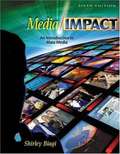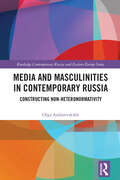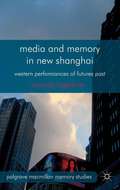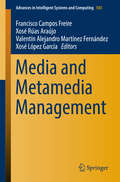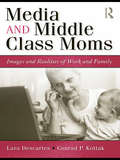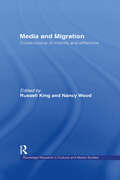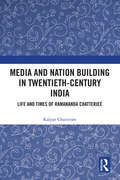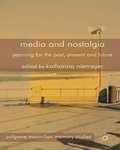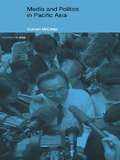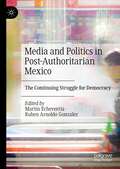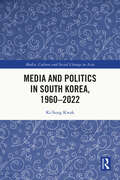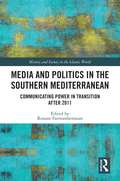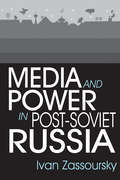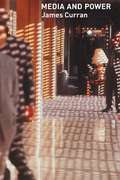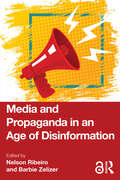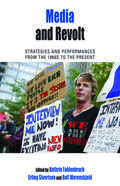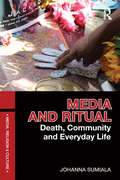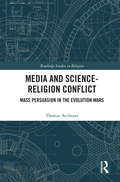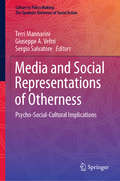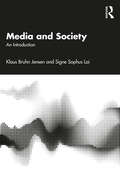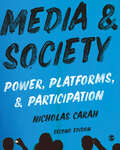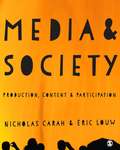- Table View
- List View
Media and Impact: An Introduction to Mass Media
by Shirley BiagiTaking an industry-by-industry approach to media issues and situating these in a global context, this textbook considers the media's influence on both individuals and whole societies. A companion CD-ROM contains CNN video clips and other supplemental materials. Biagi teaches at California State University at Sacramento. Annotation ©2004 Book News, Inc. , Portland, OR (booknews. com)
Media and Masculinities in Contemporary Russia: Constructing Non-heteronormativity (ISSN)
by Olga AndreevskikhBased on extensive original research, this book examines the extent to which media in Russia upholds the Russian government’s stance on sexuality. It considers the Russian government’s policies designed to uphold ‘traditional sexuality’, reveals the strategies of resistance used by Russian media outlets to create positive portrayals of non-heteronormative people and circumvent the restrictive 2013 legislation banning positive representations of ‘non-traditional sexual relations’, and highlights particular examples of subversive media practices. Overall, the book challenges the prevailing view that media in authoritarian regimes are completely compliant with their government’s position.
Media and Masculinities in Contemporary Russia: Constructing Non-heteronormativity (Routledge Contemporary Russia and Eastern Europe Series)
by Olga AndreevskikhBased on extensive original research, this book examines the extent to which media in Russia upholds the Russian government’s stance on sexuality. It considers the Russian government’s policies designed to uphold "traditional sexuality", reveals the strategies of resistance used by Russian media outlets to create positive portrayals of non-heteronormative people and circumvent the restrictive 2013 legislation banning positive representations of "‘non-traditional sexual relations", and highlights particular examples of subversive media practices. Overall, the book challenges the prevailing view that media in authoritarian regimes are completely compliant with their government’s position.
Media and Memory in New Shanghai
by Amanda LagerkvistContributing to current debates about the globality and mediatisation of memories, Media and Memory in New Shanghai interrogates the city's spectacular regeneration into an emergent world centre, describing how Western elites partake in the production of New Shanghai by feeling its futures and performing its futures past.
Media and Metamedia Management
by Francisco Campos Freire Xosé Rúas Araújo Valentín Alejandro Martínez Fernández Xosé López GarcíaMedia and Metamedia Management has contributions from seven prestigious experts, who offer their expertise and the view from their vantage point on communication, journalism, advertising, audiovisual, and corporate, political, and digital communication, paying special attention to the role of new technologies, the Internet and social networks, also from an ethics and legal dimension. A total of 118 authors belonging to 31 universities from Spain, Portugal, England and Ecuador have contributed to this book edited, coordinated and introduced by professors Francisco Campos-Freire and Xos#65533; L#65533;pez-Garc#65533;a, from the University of Santiago de Compostela, Jos#65533; R#65533;as-Ara#65533;jo, from the University of Vigo, and Valent#65533;n A. Mart#65533;nez-Fern#65533;ndez, from the University of A Coru#65533;a. Readers may also enjoy 66 articles, grouped into diverse chapters, on Journalism and cyberjournalism, audiovisual sector and media economy, corporate and institutional communication, and new media and metamedia.
Media and Middle Class Moms: Images and Realities of Work and Family
by Conrad Kottak Lara J. DescartesWritten by nationally recognized anthropologists Conrad Kottak and Lara Descartes, this ethnography of largely white, middle class families in a town in the midwest explores the role that the media play in influencing how those families cope with everyday work/family issues. The book insightfully reports that families struggle with, and make work/family decisions based largely on the images and ideas they receive from media sources, though they strongly deny being so influenced. An ideal book for teaching undergraduate family, media, and methods courses.
Media and Migration: Constructions of Mobility and Difference (Routledge Research in Cultural and Media Studies #Vol. 8)
by Nancy Wood Russell KingThis title explores the close and vital relationship between the contemporary media and immigration. Drawing on newspapers, magazines, film, television and photography, the contributors examine the effects of mass media on migration behaviour and ethnic identity. Using examples from a range of countries, Media and Migration illustrates how the media intervenes to affect the reception migrants receive, how it stimulates prospective migrants to move and how it plays a dynamic role in the cultural politics and cultural identity of diasporic communities.
Media and Nation Building in Twentieth-Century India: Life and Times of Ramananda Chatterjee
by Kalyan ChatterjeeThis book profiles twentieth-century India through the life and times of Ramananda Chatterjee – journalist, influencer, nationalist. Through a reconstruction of his history, the book highlights the oft-forgotten role of media in the making of the idea of India. It shows how early twentieth-century colonial India was a curious melee of ideas and people – a time of rising nationalism, as well as an influx of Western ideas; of unprecedented violence and compelling non-violence; of press censorship and defiant journalism. It shows how Ramananda Chatterjee navigated this world and went beyond the traditional definition of the nation as an entity with fixed boundaries to anticipate Benedict Anderson and Ernest Gellner. The volume also examines the wide reach and scope of his journals in English, Hindi and Bengali, which published the likes of Rabindranath Tagore, Subhash Bose, Abanindranath Tagore, Nandalal Bose, Ananda Coomaraswamy, the scientist J. C. Bose and Zhu Deh, the co-founder of the Chinese Red Army. He also published India in Bondage by the American Unitarian minister J. T. Sunderland, which resulted in his arrest. An intriguing behind-the-scenes look of early twentieth-century colonial India, this book will be of great interest to scholars and researchers of history, modern South Asia and media and cultural studies.
Media and Nostalgia
by Katharina NiemeyerMedia and Nostalgia is an interdisciplinary and international exploration of media and their relation to nostalgia. Each chapter demonstrates how nostalgia has always been a media-related matter, studying also the recent nostalgia boom by analysing, among others, digital photography, television series and home videos.
Media and Politics in Pacific Asia (Politics in Asia)
by Duncan McCargoMedia and Politics in Pacific Asia is the first book to provide a detailed account of the political influences exerted by both domestic and international media in Pacific Asia. Duncan McCargo argues that the media are political actors and institutions in their own right, and that as such they can play a variety of political roles, some of which support processes of demographic transition and consolidation, and some which do just the opposite. Drawing on first-hand research in Hong Kong, Indonesia, Japan and Thailand - and employing comparative examples that include Burma, Malaysia and the Phillipines - Duncan McCargo examines the various influences of the Media as agents of stability, restraint and change. He also analyses pressures on the media from a range of state, non-state and market forces, and sets out to problematize simplistic readings of issues such as media freedom, ownership, partisanship, profitability, regulation and public interest. The result is an in-depth and fascinating study of the interplay between the media and the political process. Written in a clear and accessible style with numerous examples, this highly original book will be useful to academics, students, journalists, and general readers interested in Asian studies, media and politics.
Media and Politics in Post-Authoritarian Mexico: The Continuing Struggle for Democracy
by Martin Echeverria Ruben Arnoldo GonzalezThis volume presents an analytical and empirical overview of the array of issues that the Mexican media faces in the post-authoritarian age, which jointly explains how a partially accomplished democracy, its authoritarian inertias, and its unintended consequences hinder the democratic performance of the media. This is analyzed from three points of view: the stalemate Mexican media system and ineffective regulations, the conditions of risk and insecurity of the journalists on the field, and the limits of freedom of expression, political substance, and inclusiveness of media content. A binational effort, with research from US and Mexican authors, a wide analytic perspective is provided on the macro, meso, and micro levels, allowing for a deep conceptual richness and a comprehensive understanding of the Mexican case. With leading researchers in the field, the volume revolves around the problems of the media in post-authoritarian democracies. By answering the questions of how and why the Mexican media has not fully democratized, the works encompassed here can resonate with and are relevant to other post-authoritarian countries and academic disciplines.
Media and Politics in South Korea, 1960-2022 (Media, Culture and Social Change in Asia)
by Ki-Sung KwakThis book examines the constantly changing nature of the relationship between the state and the media within South Korea’s political landscape. It traces developments as South Korea became gradually more democratic in the decades after 1960, and goes on to consider more recent developments which include democratic erosion and the deepening political division and their effects on the media, including the paralleling of this deepening political division within the media itself. It explores the issues that have affected the relationship between the media and the political power, assesses the impact of new developments in media and communication technologies, and concludes by discussing how the legacy of authoritarianism has affected political reporting and the press-party relationship.
Media and Politics in the Southern Mediterranean: Communicating Power in Transition after 2011 (History and Society in the Islamic World)
by Roxane FarmanfarmaianThis edited volume presents ground-breaking empirical research on the media in political transition in Tunisia, Turkey and Morocco. Focusing on developments in the wake of the region’s upheavals in 2011, it offers a new theoretical framework for understanding mediascapes in the confessional and hybrid-authoritarian systems of the Middle East. In this book, media scholars focus on three themes: the media’s structure as an expression of governance, the media’s function as a reflection of the market, and the media’s agency in communicating between power and the public. The result is a unique addition to the literature on two counts. Firstly, analysis of similar players, issues and processes in each country produces a thematically consistent comparative assessment of the media’s role across the southern Mediterranean region. The first cross-country comparison of specific media practices in the Middle East, it covers issues such as women in talk shows, media’s relationship with surveillance, and comparative practices of media regulation. Secondly, actualising the idea that media reflects the society that produces it, the studies here draw on field data to lay the foundations for a new theory of media, Values and Status Negotiation (VSN), which evolved from the region’s unique characteristics and practices, and offers an alternative to prevailing Western-centric approaches to media analysis. Media and Politics in the Southern Mediterranean will appeal to students and scholars of politics, sociology, Media Studies, Cultural Studies and Middle Eastern Studies.
Media and Power in Post-Soviet Russia
by Ivan Ivanovich ZassourskyThis book describes the rise of independent mass media in Russia, from the loosening of censorship under Gorbachev's policy of glasnost to the proliferation of independent newspapers and the rise of media barons during the Yeltsin years. The role of the Internet, the impact of the 1998 financial crisis, the succession of Putin, and the effort to reimpose central power over privately controlled media empires mark the end of the first decade of a Russian free press. Throughout the book, there is a focus on the close intermingling of political power and media power, as the propaganda function of the press in fact never disappeared, but rather has been harnessed to multiple and conflicting ideological interests. More than a guide to the volatile Russian media scene and its players, Media and Power in Post-Soviet Russia poses questions of importance and relevance in any functioning democracy.
Media and Power: Alternative Media In A Networked World (Communication and Society)
by James CurranMedia and Power addresses three key questions about the relationship between media and society.*How much power do the media have?*Who really controls the media?*What is the relationship between media and power in society?In this major new book, James Curran reviews the different answers which have been given, before advancing original interpretations in a series of ground-breaking essays.This book also provides a guided tour of the major debates in media studies. What part did the media play in the making of modern society? How did 'new media' change society in the past? Will radical media research recover from its mid-life crisis? Is public service television the dying product of the nation in an age of globalization? Media and Power provides both a clear introduction to media research and an innovative analysis of media power.
Media and Print Culture Consumption in Nineteenth-Century Britain
by Paul Raphael Rooney Anna GasperiniThis book explores Victorian readers' consumption of a wide array of reading matter. Established scholars and emerging researchers examine nineteenth-century audience encounters with print culture material such as periodicals, books in series, cheap serials, and broadside ballads. Two key strands of enquiry run through the volume. First, these studies of historical readership during the Victorian period look to recover the motivations or desired returns that underpinned these audiences' engagement with this reading matter. Second, contributors investigate how nineteenth-century reading and consumption of print was framed and/or shaped by contemporaneous engagement with content disseminated in other media like advertising, the stage, exhibitions, and oral culture.
Media and Propaganda in an Age of Disinformation
by Barbie Zelizer Nelson RibeiroA critical and timely collection that argues for the centrality of propaganda in discussions about the contemporary media landscape and its informational ecosystems.This book explores how “propaganda,” a foundational concept within media and communication studies, has recently been replaced by alternative terms (disinformation, misinformation, and fake news) that fail to capture the continuities and disruptions of ongoing strategic attempts to (mis)guide public opinion. Edited by Nelson Ribeiro and Barbie Zelizer, the collection highlights how these concepts must be understood as part of a long legacy of propaganda and not just as new phenomena that have emerged in the context of the digital media environment. Chapters explore the strategies and effects of propaganda through a variety of globally diverse case studies, featuring both democracies and autocratic regimes, and highlight how only by understanding propagandistic forms and strategies can we fully begin to understand how public opinion is being molded today by those who resort to deception and falsehood to gain or keep hold of power.An important resource for students and scholars of media and communication studies and those who are studying and/or researching media and propaganda, media and power, disinformation, fake news, and political communication.The Open Access version of this book, available at http://www.taylorfrancis.com, has been made available under a Creative Commons [Attribution-Non Commercial-No Derivatives (CC BY-NC-ND)] 4.0 license
Media and Revolt
by Erling Sivertsen Rolf Werenskjold Kathrin FahlenbrachIn what ways have social movements attracted the attention of the mass media since the sixties? How have activists influenced public attention via visual symbols, images, and protest performances in that period? And how do mass media cover and frame specific protest issues? Drawing on contributions from media scholars, historians, and sociologists, this volume explores the dynamic interplay between social movements, activists, and mass media from the 1960s to the present. It introduces the most relevant theoretical approaches to such issues and offers a variety of case studies ranging from print media, film, and television to Internet and social media.
Media and Ritual: Death, Community and Everyday Life (Media, Religion and Culture)
by Johanna SumialaThis wide-ranging and accessible book offers a stimulating introduction to the field of media anthropology and the study of religious ritual. Johanna Sumiala explores the interweaving of rituals, communication and community. She uses the tools of anthropological enquiry to examine a variety of media events, including the death of Michael Jackson, a royal wedding and the transgressive actions which took place in Abu Ghraib, and to understand the inner significance of the media coverage of such events. The book deals with theories of ritual, media as ritual including reception, production and representation, and rituals of death in the media. It will be invaluable to students and scholars alike across media, religion and anthropology.
Media and Science-Religion Conflict: Mass Persuasion in the Evolution Wars (Routledge Studies in Religion)
by Thomas AechtnerThis book examines why the religion-science skirmishes known as the Evolution Wars have persisted into the 21st century. It does so by considering the influences of mass media in relation to decision-making research and the Elaboration Likelihood Model, one of the most authoritative persuasion theories. The book’s analysis concentrates on the expression of cues, or cognitive mental shortcuts, in Darwin-sceptic and counter-creationist broadcasts. A multiyear collection of media generated by the most prominent Darwin-sceptic organizations is surveyed, along with rival publications from supporters of evolutionary theory described as the pro-evolutionists. The analysed materials include works produced by Young Earth Creationist and Intelligent Design media makers, New Atheist pacesetters, as well as both agnostic and religious supporters of evolution. These cues are shown to function as subtle but effective means of shaping public opinion, including appeals to expertise, claims that ideas are being censored, and the tactical use of statistics and technical jargon. Contending that persuasive mass media is a decisive component of science-religion controversies, this book will be of keen interest to scholars of Religion, Science and Religion interactions, as well as researchers of Media and Communication Studies more generally.
Media and Social Representations of Otherness: Psycho-Social-Cultural Implications (Culture in Policy Making: The Symbolic Universes of Social Action)
by Giuseppe A. Veltri Sergio Salvatore Terri MannariniThis book presents the main findings of an empirical exploration of media discourses on social representations of “otherness” in seven European countries. It focuses on the analysis of press discourses produced over a fifteen-year period (2000–2015) on three contemporary figures of otherness that challenge the identity of European societies, question the attitudes towards diversity, and pose significant challenges for policy-makers: immigration, Islam, and LGBT. The book provides a comprehensive and articulate map of how national media addresses such themes from both synchronic and diachronic perspectives, revealing patterns of continuity and discontinuity across time and space. Lastly, it discusses these patterns in the light of their cultural meanings and their influence on social and political collective behaviours.
Media and Society: An Introduction
by Klaus Bruhn Jensen Signe Sophus LaiMedia and Society: An Introduction, offers an interdisciplinary approach to media as means of social connection in everyday life and beyond.Integrating theory and concrete analysis in case studies, exercises, and illustrative examples from around the world, Media and Society: An Introduction delivers a go-to reference work for learning about one of the essential social infrastructures of the twenty-first century. Standing on the shoulders of classic communication models, and covering legacies of research about media institutions, media texts, and media users, the chapters include both how-to sections on methods addressing current digital media forms and reflective segments that place TikTok, ChatGPT, and the emerging Internet of Things in the longer history of human communication.As a comprehensive and up-to-date textbook on key conceptual, analytical, and normative issues facing students of media and communication today, this book is a practically applicable resource for teaching and learning about media, in the classroom, in self-study, and in different world regions. As such, it is a key resource for undergraduate students and professors in the fields of media, communication, and cultural studies.
Media and Society: Power, Platforms, and Participation
by Nicholas CarahHow do media platforms organise social life? How do media empower or disempower our identities? How do we understand the impact of algorithms? How are media audiences produced and managed? Media & Society introduces the role of the media in social, cultural, political and economic life, unpacking the increasing entanglement of digital media technology with our everyday lives. It explores the relationship between meaning and power in an age of participatory culture, social media and digital platforms. An age where we both create and consume content, and where we both give and gain attention – translating our social lives into huge flows of data. Associate Professor Nicholas Carah shows how a critical approach to power helps us not only to understand the role media play in shaping the social, but also how we can become critically informed media citizens ourselves, able to participate and be heard in meaningful ways. Media & Society expertly introduces all the key concepts and ideas you need to know, and then puts theory into practice by tying them to contemporary case studies. From using Ghostery to track how your personal data is being collected, to exploring misinformation on social media via Youtube, to the reality of internships and freelancing in today’s digital media industry. It is essential reading for students of media, communication and cultural studies.
Media and Society: Power, Platforms, and Participation
by Nicholas CarahHow do media platforms organise social life? How do media empower or disempower our identities? How do we understand the impact of algorithms? How are media audiences produced and managed? Media & Society introduces the role of the media in social, cultural, political and economic life, unpacking the increasing entanglement of digital media technology with our everyday lives. It explores the relationship between meaning and power in an age of participatory culture, social media and digital platforms. An age where we both create and consume content, and where we both give and gain attention – translating our social lives into huge flows of data. Associate Professor Nicholas Carah shows how a critical approach to power helps us not only to understand the role media play in shaping the social, but also how we can become critically informed media citizens ourselves, able to participate and be heard in meaningful ways. Media & Society expertly introduces all the key concepts and ideas you need to know, and then puts theory into practice by tying them to contemporary case studies. From using Ghostery to track how your personal data is being collected, to exploring misinformation on social media via Youtube, to the reality of internships and freelancing in today’s digital media industry. It is essential reading for students of media, communication and cultural studies.
Media and Society: Production, Content and Participation
by Nicholas Carah Eric Louw'This is the media and society text that critical scholars have been waiting for'. - Professor Mark Andrejevic, Pomona College This book unpacks the role of the media in social, cultural and political contexts and encourages you to reflect on the power relationships that are formed as a result. Structured around the three cornerstones of media studies; production, content and participation, this is an ideal introduction to your studies in media, culture and society. The book: Evaluates recent developments in media production, industries and platforms brought about the emergence of interactive media technologies. Examines the shifting relationship between media production and consumption instigated by the rise of social and mobile media, recasting consumption as ‘participation’. Explores the construction of texts and meanings via media representations, consumer culture and popular culture, as well as the relationship between politics and public relations. Assesses the debates around the creative and cultural labour involved in meaning-making. Includes a companion website featuring exercise and discussion questions, links to relevant blogs and web material, lists of further reading and free access to key journal articles.
